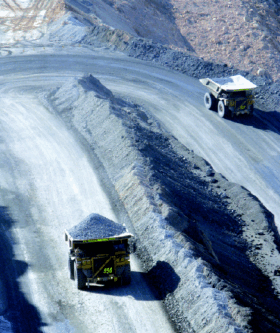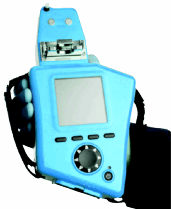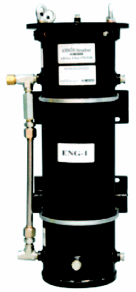It’s a time-worn adage, but still true: pay now or pay later. When it comes to proper lubrication of mine equipment, a few dollars spent now can help avoid major unplanned costs in the future.
 |
| Haul trucks, in particular, can challenge the protective qualities of even premium engine lubricating oils. Long uphill hauls at full load can elevate oil temperatures to damaging levels, resulting in possible additive depletion, oxidation, varnishing, corrosion and increased frequency of oil changes. |
Mine operators—pressured on one side by rising material and labor costs, and on the other by softening commodities markets—are naturally interested in getting the last ton of productivity out of their primary fleet equipment, at the lowest operating cost. Under these circumstances, it’s tempting to consider measures that could lead to lower expenses for two of the major consumables involved in loading and haulage: fuel and lubrication products such as engine oil.
But when it comes to lubrication, cutting corners—extending oil change intervals, using cheaper filters, or simply ignoring oil condition, for example—can result in false economies. As the following case histories illustrate, real savings are often generated by investing attention and relatively small amounts of money to maintain proper lube standards and service, avoiding the much larger costs of premature engine overhauls, unscheduled downtime and failure to reach projected equipment service-life goals, among others.
Cutting Consumption, Raising Productivity
ExxonMobil recently reported that the introduction of its synthetic heavy-duty diesel engine oil, Mobil Delvac 1 ESP 5W-40, had resulted in significant performance benefits for a Mexican mining customer, including the reduction of oil consumption and the extension of oil drain intervals.
Newmont Mining Corp. holds a 44% ownership interest in the open-pit La Herradura gold mine, located 250 miles (400 km) south of Mesquite in the northern Mexican state of Sonora. Fresnillo plc owns the remaining interest in the mine and is the operator. Construplan, the mining contractor, operates more than 40 pieces of heavy-duty equipment at La Herradura, ranging from haul trucks and excavators to heavy-duty pickup trucks. This equipment encounters extreme temperatures ranging from 50°C (125°F) in the summer to -10°C in the winter (-14°F).
ExxonMobil said that after switching to Mobil Delvac 1, Construplan reported benefits that include enhanced equipment performance, increased uptime, improved fuel economy and extended oil drain intervals when compared to conventional mineral oils. As a result, Construplan has been able to reduce oil consumption, minimize used oil waste, and maximize the overall productivity of its equipment and people.
Mobil explained that its Delvac 1 heavy-duty engine oils are part of a mining-focused product line that includes Mobil SHC synthetic oil and greases, and Mobil DTE Series high-performance hydraulic fluids. These products, according to the company, can deliver a range of performance benefits, including prolonged equipment life, improved energy efficiency and extended oil life when compared to conventional mineral oils.
“With mining equipment often subjected to extremely heavy loads and operating in challenging environments, mine operators can sometimes find it challenging to find the right solutions that will help enhance efficiency and increase productivity,” said Umut Urkun, industrial lubricants marketing advisor—Europe, Africa and Middle East, ExxonMobil Fuels and Lubricants. “We have worked closely with mining professionals for more than 50 years to obtain the necessary insights required to formulate products that help to maximize productivity in a safe and cost-efficient way.”
Results from Ray
Across the border from Sonora, Grupo Mexico’s Asarco Ray operations are located 64 miles southeast of Phoenix, Arizona, USA. The Ray complex comprises a 250,000-t/d open-pit mine with a 30,000-t/d concentrator, a 103-million-lb/y solvent extraction and electrowinning operation, and associated maintenance, warehouse and administrative facilities.
 |
| Spectro Inc. claims its FluidScan Q1100 handheld infrared oil analyzer enables users to determine when oil is no longer fit for use due to contamination or degradation. |
The mine operates a fleet of 39 haul trucks, 21 of which are Liebherr T 282s. These 400-ton ultra-class trucks, powered by 20-cylinder MTU diesels, operate 22 hours a day, seven days a week, in harsh and often extremely hot conditions. Asarco Ray management selected Chevron’s Delo 400 Multigrade 15W-40 as the standard engine oil for these haulers.
Chevron’s senior consulting scientist, Jim McGeehan, visited the mine recently to inspect one hauler’s MTU 20V 4000 engine that had racked up 21,900 hours of operation, and had been serviced at 500-hour intervals. The engine was torn down and the findings, according to McGeehan, were impressive.
Wrist pin bushings on the 20V 4000’s 20 pistons were found to be in excellent condition. The lands were free of deposits, while the crowns showed minimum deposits. When looking at the rings of one piston, McGeehan said, “The oil ring groove is absolutely clean. … The top ring is in a good wear pattern. … Then the oil scraper ring, all the rails are in perfect condition.”
The main bearings also were in excellent condition with no overlay removal. “It’s important to remember that this engine is operated at 3,650 brake horsepower, with oil drain intervals of 500 hours…These bearing are in excellent condition. In fact, you can put these back in the engine,” said McGeehan.
According to Jerry Martinez, customer support manager for W.W. Williams, which provides service and support for Asarco’s heavy-duty equipment, being able to extend the life of key engine components in vehicles like these can save “hundreds of thousands of dollars” across the whole fleet.
“In today’s market, these engines go new for somewhere between $550,000 to $560,000. They probably overhaul for about $480,000 per engine, said Martinez. “When you can add 15% or 20% to the life cycle of an engine, then the customer is going to get a return.
“I’m not going to [have to] replace all these rocker arms, I’m not going to replace the camshaft or the swingers. I’m going to put in a set of pistons, bearings and gaskets and put this engine back to work for another 25,000 hours or so,” he said.
According to Senior Maintenance Planner Scott Jackson, the benefits of increasing engine life from 20,000 to 27,000 hours are clear to the mine. “We are actually saving approximately $160,000 per engine per year. The mine runs a fleet of 21 trucks, so you are looking at roughly $3,000,000 in savings per year and 7,000 hours equates to more than a year’s operating time at the mine.”
Eliminate Grease-grade Guesswork
The benefits of proper lubrication choice and an attentive vendor aren’t limited to engine applications. Bel-Ray Company, a New Jersey, USA-based supplier of industrial and retail lubricants, recently assisted a large quarry operation in Trinidad in solving an ongoing problem related to grease supply in its screen installations, which use large double spherical bearings. The company was using a lithium complex NLGI 2 grade with a base oil viscosity of 144 cSt at 40°C and 11.7 cSt at 100°C, in a pneumatic lubrication system. The NLGI 2 grease wouldn’t slump into the suction tube of the grease pump and, consequently, the bearings were not getting greased sufficiently—and even when they were getting the proper amount of lubrication, they didn’t last long due to the grease’s low base oil viscosity.
Bel-Ray, working with the Trinidad distributor, found that the bearings had an inside diameter of 140 mm and an outside diameter of 300 mm, and operated at 200 rpm. Operating temperature was 70°C. Based on this information, Bel-Ray Technical Services calculated the Ndn value and minimum base oil viscosity, which was 55 cSt at operating temperature. To provide the correct base oil viscosity, the Kappa value was calculated, which determines the correct base oil viscosity at operating temperature under the type of load to which the bearing is being exposed. In this application, Bel-Ray determined a heavy load Kappa value of 4 would be appropriate—four times the minimum base oil viscosity.
After calculating that the viscosity of the base oil at 70°C was 196 cSt, the Kappa value was determined to be 196 / 55 = 3.56—very near to the desired Kappa value of 4. Bel-Ray Molylube Extreme Pressure High Viscosity Grease 1000-1 was then selected due to its heavy (1000 cSt at 40°C) base oil viscosity.
The recommended high-viscosity grease was applied via the screen’s auto lube system, with good results: The NLGI 1 grade provided the correct slumping performance, and the heavy base oil of the grease provided the required lubrication.
Quick On-site Analysis
Even when the correct lubricant has been selected, eventual “lubrication abnormalities” can occur and cause unexpected equipment downtime. To prevent those costly occurrences, Spectro Inc. claims its FluidScan Q1100 handheld infrared oil analyzer enables users to determine when oil is no longer fit for use due to liquid contamination or degradation. The compact instrument provides direct, immediate measurement of water, total acid number (TAN), oxidation, glycol, total base number (TBN), and other parameters via Spectro’s patented Direct Infrared Spectroscopy (DIR) technology.
The route-based capability of the FluidScan Q1100’s operation allows the device to mostly eliminate mislabeled samples and long wait times for laboratory analysis. The results highly correlate to TAN and TBN laboratory tests conducted with ASTM D664 and D4739 titration methods and water tests with the ASTM D6304 Karl Fischer Titration method.
Routes, similar to thermography or vibration routes, can be downloaded from Emerson Process Management’s AMS Suite’s OilView software to the Q1100. Results can be uploaded back into OilView. Oil data can be analyzed, along with data from other predictive maintenance techniques, in the Emerson AMS software for Machinery Health Management. The Q1100 includes a large and expandable reference library of industrial mineral and synthetic lubricants for gearboxes, compressors and hydraulic systems.
Emerson Process Management and Spectro joined forces in this sector last year, announcing in September an exclusive alliance to combine technical innovation and expertise to deliver expanded oil analysis solutions.
Under the agreement, Spectro gained rights to a suite of Emerson-developed and patent protected intellectual property in the field of oil analysis for predictive machine maintenance. Included in the IP portfolio are Emerson’s AMS Suite oil analysis software module as well as the CSI 5200 machinery health oil analyzer—a multi-functional analyzer that is capable of detecting most lubricant-related problems in gears, pumps, compressors, turbines, engines, hydraulics and process machinery. Spectro is now the exclusive, world wide supplier of the CSI 5200 analyzer product and services offering.
Stepping Up Filtration Efficiency
When oil analysis highlights an ongoing problem, it also offers an opportunity to find a solution that can reduce equipment maintenance costs and increase uptime. For example, a surface coal mining operation in Montana, USA, recently conducted oil analysis and found the service life of its production-fleet engines was being cut short by wear caused by particles that the engines’ OEM full flow filtration system was not designed to remove. The fleet includes haul trucks, loaders and bulldozers. The first vehicles analyzed were Cat 992G wheel loaders equipped with 3508B engines that hold 27 gallons of SAE 15W-40 engine oil. Analysis on one 992G in the fleet indicated a particle count, by pore blockage method, of 22/21/18 with copper and iron levels at 118 ppm and 53 ppm, respectively. Analysis on the other loaders indicated similar conditions.
 |
| Des-Case Corp.’s engine filtration kits continually filter small amounts of engine oil through one or two filter canisters, depending the system configuration. |
Des-Case Corp., a manufacturer of customizable filtration solutions for industry applications—including innovative dedicated filtration systems specifically tailored for mobile equipment—recommended and provided one of its ENG-2 filtration kits for one of the mine’s loaders.
The ENG-2 kit, according to the company, provides filtration with depth media for a constant contamination control solution at very low ISO cleanliness levels. The system works by taking a small volume of the oil flow downstream from the OEM full flow filter and directing it through the ENG-2 system. Oil flows through the canisters at a set rate and is returned directly to the engine sump. The system is designed to prevent the canisters from being emptied when the equipment is shut down, while the small amount of oil directed through the ENG-2 system at any given time ensures the engine is never starved of oil. A pressure relief valve is also installed to prevent accidental over-pressuring of the canisters during cold cranking.
The ENG-2 is a depth-type secondary filtration system. The system is designed to meter engine oil flow through the filters at 0.5 gpm. This slow flow rate, combined with the depth filtration, allows the system to have significant impact on soot and particles less than 1 micron in size.
Target cleanliness levels at the time of installation were established at ISO 19/17/14 which, compared with the engine oil cleanliness prior to installation of ISO 22/21/18, were estimated to yield a 16-fold reduction in particle contamination inside the engine, resulting in a projected three-fold extension of engine life.
After 931 hours with the new filtration system, oil analysis was conducted and indicated that ISO cleanliness levels had been reduced from ISO 22/21/18 (c) to ISO 17/16/13 (c), soot levels were maintained at or below 0.1% vol, copper levels dropped from 118 ppm to 2 ppm, and iron levels dropped from 53 ppm to 7 ppm. Based on life extension projections, cleanliness levels of ISO 17/16/13 (c) in an engine should result in a four-fold increase in engine life.
Purchase and installation costs of the engine filtration kit were approximately $3,000, with an annual replacement element cost of about $1,000–$2000. A typical “top end” engine overhaul costs at minimum $12,000–$15,000. Based on the target cleanliness levels achieved, the top end overhaul interval is now projected to increase from an average of 13,500 hours to 54,000 hours, resulting in a net present value savings across the mines fleet of six loaders of $129,841 over five years, at an annualized rate of return of 216%. To date, Des-Case reports that the mine has been able to sustain the improved levels of fluid cleanliness achieved with the engine kit and paid off its investment in the system in a little over five months.
Make it Part of the Program
The benefits of an oil analysis program can be maximized when it becomes part of a company-wide, management-supported effort. For example, the Hibbing Taconite Co., an 8-million-t/y magnetite operation located in Minnesota’s Mesabi Iron Range and managed by Cliffs Natural Resources, won Uptime magazine’s Best Lubrication Program award in 2012; an important element of Hibbing’s condition-monitoring program is the oil analysis component of its lubrication program.
In the first phase of the program, reliability engineers were trained as Level I Machine Lubrication Technicians (MLT1), and dedicated lubrication mechanics were assigned in the plants to monitor equipment oil conditions. During the second phase, MLT1 training continued, involving lubrication mechanics and supervisors. Critical equipment received lubrication upgrades such as desiccant breathers, sight tubes, sample ports and quick couplers for filtering, allowing for safer filter changes and reducing cross-contamination risk.
Currently, 80 Hibbing employees have received MLT1 training for machinery lubrication and basic oil analysis. Management reportedly regards the program as an investment.
Overall, fluid analysis has been consolidated across all Cliff operations, using a single oil analysis laboratory that was selected after ranking sample results from several labs. This approach provides consistency as well as the ability to review and compare data. Sample standards were determined in accordance with equipment specs, sample ports were installed where needed and personnel were trained on how to collect samples. The CMMS system controls sample frequency.
In addition, the maintenance team installed oil moisture sensors to allow real-time condition monitoring, resulting in a reduction in overall site oil consumption by removing water contamination. Dedicated lube carts were made available to enable quick, clean and safe fluid changes with fewer opportunities for spillage. And, all machines were tagged with machine identification and lubrication information to reduce service errors and contamination problems.






